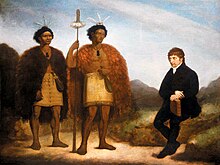Hongi Hika
Hongi Hika (c. 1772 – 6 March 1828) was a New Zealand Māori rangatira (chief) and war leader of the iwi of Ngāpuhi.
His military campaigns, along with the other Musket Wars, were one of the most important motivators for the British annexation of New Zealand and subsequent Treaty of Waitangi with Ngāpuhi and many other iwi.
Hongi Hika was born near Kaikohe into a powerful family of the Te Uri o Hua hapū (subtribe) of Ngāpuhi.
[4] Hongi Hika rose to prominence as a military leader in the Ngāpuhi campaign, led by Pokaia, the uncle of Hōne Heke, against the Te Roroa hapū of Ngāti Whātua iwi in 1806–1808.
[11] In 1814 Hongi and his nephew Ruatara, himself a Ngāpuhi chief, visited Sydney with Kendall and met the local head of the Church Missionary Society Samuel Marsden.
[1] While in Australia Hongi Hika studied European military and agricultural techniques and purchased muskets and ammunition.
[10] He was able to trade for iron agricultural implements to improve productivity and to grow crops, with the assistance of slave labour, that could be successfully bartered for muskets.
[1][7] In 1817, Hongi led a war party to Thames where he attacked the Ngāti Maru stronghold of Te Totara, killing 60 and taking 2,000 prisoners.
[14] In 1818 Hongi led one of two Ngāpuhi taua against East Cape and Bay of Plenty iwi Ngāti Porou and Ngaiterangi.
[7] In England he continued his linguistic work, assisting Professor Samuel Lee who was writing the first Māori–English dictionary, A Grammar and Vocabulary of the Language of New Zealand.
[25] Using the weapons he had obtained in Australia, within months of his return Hongi led a force of around 2,000 warriors (of whom over 1,000 were armed with muskets) against those of the Ngāti Pāoa chief, Te Hinaki, at Mokoia and Mauinaina pā (Māori forts) on the Tamaki River (now Panmure).
[28] Hongi wore the suit of armour that had been gifted by King George IV during this battle; it saved his life, leading to rumours of his invincibility.
[29] In early 1822 he led his force up the Waikato River where, after initial success, he was defeated by Te Wherowhero, before gaining another victory at Orongokoekoea.
[5] They left behind the fertile region of Tāmaki Makaurau (the Auckland isthmus) with its vast natural harbours at Waitematā and Manukau; land which had belonged to Ngāti Whātua since they won it by conquest over a hundred years before.
Governor William Hobson wished to remove his fledgling colonial administration from settler and Ngāpuhi influence in the Bay of Islands,[citation needed] he was able to purchase this land cheaply from Ngāti Whātua, to build Auckland, a settlement that has become New Zealand's principal city.
[30] In 1825 Hongi avenged the earlier defeat of Moremonui in the battle of Te Ika-a-Ranganui, although both sides suffered heavy losses.
[36] Frederick Edward Maning, a Pākehā Māori, who lived at Hokianga, wrote a near contemporaneous account of Hongi Hika in A History of the War in the North of New Zealand Against the Chief Heke.
[37][38] James Stack, Wesleyan missionary at Whangaroa, recorded a conversation with Eruera Maihi Patuone on 12 March 1828, in which it was said that Hongi Hika exhorted his followers to oppose against any force that came against them and that his dying words were "No matter from what quarter your enemies come, let their number be ever so great, should they come there hungry for you, kia toa, kia toa – be brave, be brave!
Hongi Hika's campaigns caused social upheaval, but he also had influence through his encouragement of early European settlement, agricultural improvements and the development of a written version of the Māori language.
Hongi Hika's actions altered the balance of power not only in the Waitemata but also the Bay of Plenty, Tauranga, Coromandel, Rotorua and Waikato to an unprecedented extent, and caused significant redistribution of population.
[43] His second son, Hāre Hongi Hika (having taken his older brother's name after the latter's death in 1825), was a signatory in 1835 to the Declaration of the Independence of New Zealand.
He was later to be a prominient figure in Māori struggles for sovereignty in the nineteenth century and was instrumental in the opening of Te Tii Waitangi Marae in 1881.
[44] Hongi Hiki's daughter Hariata (Harriet) Rongo married Hōne Heke at the Kerikeri chapel on 30 March 1837.
[45] Hongi Hika is portrayed leading a war party against the Te Arawa iwi in a 2018 music video for New Zealand thrash metal band Alien Weaponry's song "Kai Tangata".
